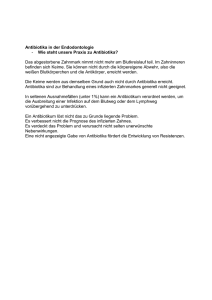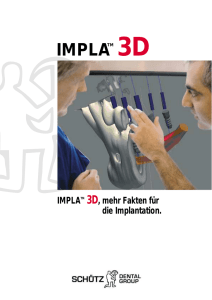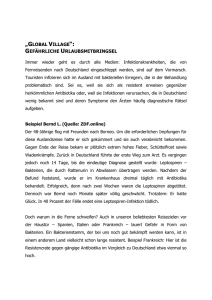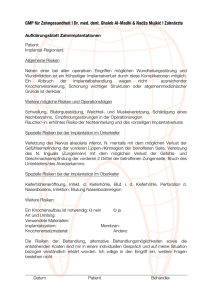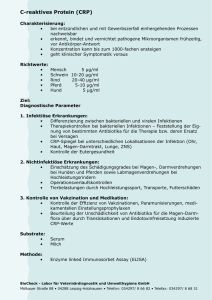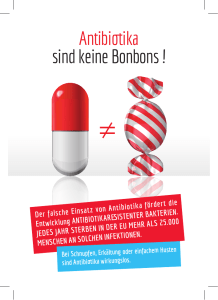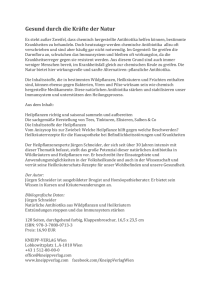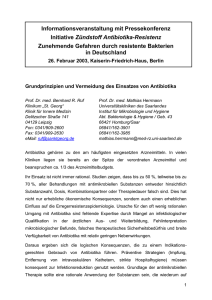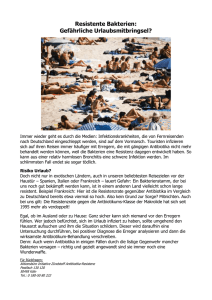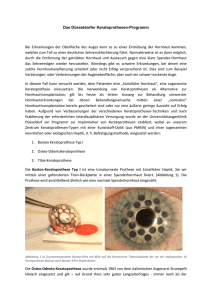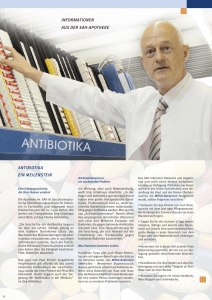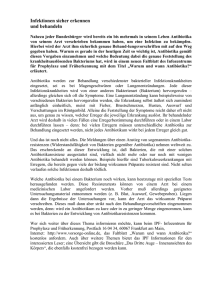Therapie von Implantatinfektionen - PEG
Werbung
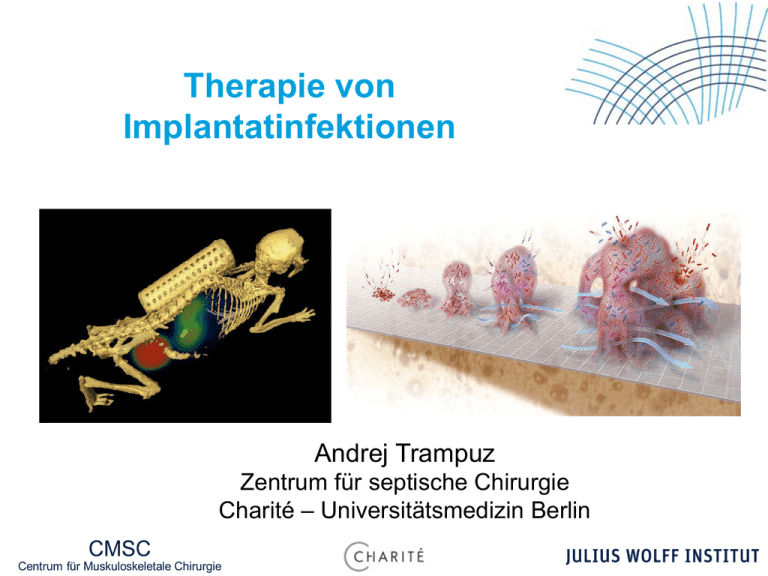
Therapie von Implantatinfektionen Andrej Trampuz Zentrum für septische Chirurgie Charité – Universitätsmedizin Berlin Implantate & Lebensqualität Gelenkersatz • Eine der erfolgreichsten Erfindungen in der Medizin • Verbesserung der Lebensqualität Hip and knee replacements in Europe Germany Austria Belgium Norway Switzerland France Luxembourg Sweden Netherlands United Kingdom Finland Slovenia Denmark Iceland Italy EU Greece Ireland Latvia Spain Hungary Estonia Portugal Romania Poland Cyprus 289 243 240 231 226 220 217 207 205 195 195 189 174 165 154 153 140 126 107 96 96 91 85 46 39 15 0 100 200 Per 100 000 population Hip replacements in 2013 300 Germany Austria Finland Switzerland Belgium Luxembourg United Kingdom Netherlands Iceland France Sweden EU Spain Denmark Italy Slovenia Latvia Portugal Hungary Cyprus Ireland Romania 206 187 184 179 168 155 146 119 119 114 110 107 106 106 97 79 61 54 47 46 45 5 0 100 200 Per 100 000 population 300 Knee replacements in 2013 Source: OECD Health Data 2015; Eurostat Statistics Database Risiko einer Infektion Implantat Anzahl Implantationen in den USA/Jahr Infektrate, % Osteosynthesen 2,000,000 5–10 Zahnimplantate 1,000,000 5–10 Gelenkprothesen 600,000 1–3 Gefässprothesen 450,000 1–5 Schrittmacher 300,000 1–7 Brustimplantate 130,000 1–2 Mech. Herzklappen 85,000 1–3 Penile Implantate 15,000 1–3 700 25–50 LVAD Darouiche RO. Clin Infect Dis 2011;33:1567–1572 Was sollen wir tun? • Tumor-Chirurgie? • Arthrodese? • Amputation? Erfolg: interdisziplinäres Konzept Infektiologe Apotheker Mikrobiologe Diagnose Antibiotika Chirurgie Orthopäde/Unfallchirurge, Plastiker, Anästhesie/ICU Ursprung der Mikroorganismen Antibiotika Bacteriostatic Bactericidal LIPOGLYCOPEPTIDE TETRACYCLINE Telavancin Dalbavancin GLYCOPEPTIDE Tigecycline OXAZOLIDINONE Linezolid LIPOPEPTIDE BETA-LACTAMS Daptomycin QUINOLONES Moxifloxacin Ceftaroline Levofloxacin OTHER Azithromycin OTHER Teicoplanin Co-amoxiclav Ciprofloxacin Amikacin Rifampin Cefazolin Minocycline Doxycycline Fusidic acid AMINOGLYCOSIDE Amoxicillin Clindamycin Fosfomycin Cephaloridine Oxacillin Nalidixic acid Ampicillin Flucloxacillin Nafcillin Methicillin Vancomycin Oxytetracycline Streptomycin Penicillin Rolinson GN. Int J Antimicrob Agents 2007;29:3–8 Gentamicin Chirurgie Schlüssel zum Erfolg: Konzept 1. Diagnositik 2. Antibiotika gegen Biofilme gerichtet 3. Chirurgie Heilungsrate >90% Infektion: gut behandelbare Komplikation! Neue Konzepte Pocket Guide: www.pro-implant-foundation.org Pocket Guide: www.pro-implant-foundation.org Pocket Guide: www.pro-implant-foundation.org Consultation service: www.pro-implant-foundation.org Biofilm Interaktion: Biofilm, Implantat und Wirt Antibiotika Resistenz Mikroorganismus (Biofilmbildung) Implantat (Materialeigenschaften) Wirt (Entzündungsreaktion) Biokompatibiität Biofilm 1 min 3h 12 h 1 Tag • Adhäsion an Oberfläche (min-h) • Eingebettet in Matrix (70%) • Langsam replizierend („stacionary-growth“) 3 Tage Klassifikation Akute Protheseninfektion Chronische Protheseninfektion Pathogenese Perioperativ früh postoperativ <4 Wochen nach OP verzögert (low-grade) ≥4 Wochen nach OP (typischerweise 3 Monate bis 3 Jahre) Hämatogen oder per continuitatem Symptomdauer <3 Wochen Symptomdauer ≥3 Wochen Biofilm (Reife) unreif reif Akute Schmerzen, Fieber, gerötetes, geschwollenes Gelenk, prolongierte Sekretion postop Hoch-virulent: Staphylococcus aureus, gramnegative Bakterien (z.B. E. coli, Klebsiella,) Chronische Schmerzen, Lockerung der Prothese, Fistel Klinik Verursachende Erreger Chirurgische Behandlung Débridement und Erhalt der Prothese (Wechsel der mobilen Teile) Niedrig-virulent: Koagulase-negative Staphylokokken (z.B. Staphylococcus epidermidis), Propionibacterium acnes Prothesenwechsel (ein-, zwei- oder mehrzeitig) Klassifikation Akut Zeit nach Implantation <1 Monat früh postoperativ Route 3–36 Monate jederzeit verzögert (low grade) spät Perioperativ Zeichen Akut: Fieber, Erguss, Chronisch: Persist. Überwärmung, Schmerzen, Wunddehiszenz Lockerung, Fistel Pathogen Staph. aureus Streptococci Enterococci Staph. epidermidis Propionibacterium acnes Chronisch Hämatogen Akut oder subakut S. aureus E. coli Postoperativ prolongierte Sekretion • Kontrolle des CRPs sollte nach Operation kontinuierlich fallen! • Ausschluss (und Behandlung) anderer potentieller Ursachen einer Sekretion ( Koagulopathie, Hämatom, Anasarka und Albuminmangel) Niederschwellige Indikationsstellung für Revision bei Sekretion >7 Tage Acute pain & fever, 10 y after implantation Relevanz der chirurgischen Therapie Antibiotika 10 Resistente Bakterien Bakterienzahl (log) 9 8 Keine Operation 7 6 5 Insuffizientes Débridement 4 3 2 1 Gründliches Débridement (+/- lokale Antibiotika) 0 Zeit Wichtigkeit des Wechsels der mobilen Teile Akute PJI Hüfte und Knie Intervention Kein Wechsel der mobilen Teile Klinischer Erfolg 4/52 (7%) Débridement & Erhalt Wechsel der mobilen Teile 50/55 (91%) • 78-jährige Frau • Primärimplantation Hüft-TEP 09/2013 (zementiert) • Schmerzen seit Implantation (4 Monate), Gehstrecke aktuell noch 20m • CRP normal, keine Lockerungszeichen im Rx Aspiration 4 Monate nach Implantation Welches Antibiotikum? Entfernung des gesamten Fremdmaterials 2 years 16% Kaplan-Meier Analyse von 112 Prosthesen 69% Portillo ME et al. CORR 2013 Abgestimmtes Behandlungskonzept Chirurgische und antibiotische Therapie Heilungsrate >90% Behandlungsalgorithmus Akute Infektion Chronische Infektion - Problemerreger? - Schlechte Weichteile/Knochen? - Lockere Prothese? Nein Langzeitsuppression mittels Antibiotika, permanente Arthrodese/Girdlestone Nein Heilungsabsicht? Ja Ja Prothesenwechsel - Problemerreger? - Schlechte Weichteile/Knochen? - Fistel? - Rez. Voroperationen? Ja Nein Erhalt der Prothese Débridement & Wechsel der mobilen Teile Ein-zeitiger Wechsel Zwei-zeitiger Wechsel Drei-zeitiger Wechsel - Problemerreger? - Schlechte Weichteile/Knochen? Problemerreger - Rifampicin-resistente Staphylokokken Ciprofloxacin-resistente gram-negative Bakterien - Pilze (Candida) Nein Kurzes Intervall (2-3 w) Ja Langes Intervall (6-8 w) Unzufriedenstellender Verlauf? Chirurgisches Vorgehen Chirurgischer Eingriff Débridement, Erhalt der Prothese Einzeitiger Wechsel Zweizeitiger Wechsel (kurzes Intervall) Intervention Antibiotika (12 Wochen) Wechsel der mobilen Teile 2 W Wechsel der Prothese 10 W 2W i.v. Antibiotika Explantation Implantation 2W 2W Dreizeitiger Wechsel Débridement 10 W 1W p.o. Antibiotika ohne Biofilm-Aktivität 9W p.o. Antibiotika mit Biofilm-Aktivität Implantation Explantation Zweizeitiger Wechsel (langes Intervall) Legende 4W 1W 5W Explantation Spacerwechsel Implantation 3W 3W 1W 5W Ex- und Implantation der Prothese Wechsel der Prothese bzw. des Spacers Keine Antibiotikapause Chirurgischer Eingriff Débridement, Erhalt der Prothese Einzeitiger Wechsel Zweizeitiger Wechsel (kurzes Intervall) Intervention Antibiotika (total 12 Wochen) Wechsel der mobilen Teile 2 W Wechsel der Prothese 10 W 2W i.v. Antibiotika Explantation Implantation 2W 2W Dreizeitiger Wechsel Débridement 10 W 1W p.o. Antibiotika ohne Biofilm-Aktivität 9W p.o. Antibiotika mit Biofilm-Aktivität Implantation Explantation Zweizeitiger Wechsel (langes Intervall) Legende 4W 1W 5W Explantation Spacerwechsel Implantation 3W 3W 1W 5W Ex- und Implantation der Prothese Wechsel der Prothese bzw. des Spacers Kein Antibiotika-freies Fenster und keine Punktion vor Wiederaufbau • Kein Nutzen: ändert die Behandlung nicht • Nicht sensitiv (lokale Antibiotika bei Spacer) • Irreführend (falls falsch-positiv/Kontamination) • Zusätzliche Intervention- zusätzliches Infektrisiko • Verlängert die Behandlung (längeres Intervall, längere Immoblisation) • Drug holidays für den Patienten = Drug holidays für die BakterienImplantation wenn sich Bakterien erholt haben... Was tun bei Erregernachweis bei Reimplantation? Erregernachweis Dauer der Antibiotikatherapie auf 12 Wochen ab Erregernachweis verlängern analog ein-zeitiger Wechsel “Fast-track”-study: Short vs. long interval in two-stage prosthesis exchange Explantation Implantation 3 we Two stage (short interval) 4 weeks i.v. 8 weeks p.o. Implantation Explantation 7 weeks Two stage (long interval) 3 weeks i.v. 4 weeks p.o. 1 week i.v. 4 weeks p.o. Interval from explantation until reimplantation (hip & knee PJI) 120 110 105 100 Median (days) 80 95 Cure rate >90% 99 90 80 71 75 66 60 43 40 32 21 20 0 Year 19 Prosthetic join infection: Outcome (Charité Berlin, Winkler T et al.) Variable Long Long Short interval w/o interval with interval with optimal AB optimal AB optimal AB (n =19) (n =19) (n = 19) Patient age (years) 68,5 ± 7,7 68,6 ± 14,4 65,4 ± 9,6 Duration from implantation to infection (years) 3,2 ± 3,0 5,7 ± 5,1 4,2 ± 3,9 Interval from explantation to reimplantation 66,7 ± 12,8 66,7 ± 38 15,9 ± 5,8 Length of hospital stay (days) 25,7 ± 8,6 30 ± 10 30 ± 7 25,2 18,3 17,8 (7-68) (6–29) (8-19) 204 210 0 6 (32%) 1 (5%) 0 (0%) 2 2 0 Follow-up (months) Aufenthalt in Geriatrie im Intervall (d) Relapse of the infection No. revisionens in interval (median) Antibiotika Welche Eigenschaften müssen erfüllt sein? • Bakterizide Wirkung • Gute orale Bioverfügbarkeit • Gute Knochenpenetration • Biofilm-Aktivität Bakterizide Wirkung Bacteriostatic Bactericidal LIPOGLYCOPEPTIDE TETRACYCLINE Telavancin Dalbavancin GLYCOPEPTIDE Tigecycline OXAZOLIDINONE Linezolid LIPOPEPTIDE BETA-LACTAMS Daptomycin QUINOLONES Moxifloxacin Ceftaroline Levofloxacin OTHER Azithromycin OTHER Teicoplanin Co-amoxiclav Ciprofloxacin Amikacin Rifampin Cefazolin Minocycline Doxycycline Fusidic acid AMINOGLYCOSIDE Amoxicillin Clindamycin Fosfomycin Cephaloridine Oxacillin Nalidixic acid Ampicillin Flucloxacillin Nafcillin Methicillin Vancomycin Oxytetracycline Streptomycin Penicillin Rolinson GN. Int J Antimicrob Agents 2007;29:3–8 Gentamicin Antibiotika mit Biofilm-Aktivität • Rifampicin (in Kombination): für grampositive Erreger (Staphylokokken, Propionibacterium) • Ciprofloxacin: für gramnegative Erreger (E. coli, Klebsiella, Enterobacter, Pseudomonas) • Streptokokken: Penicillin / Amoxicillin • Enterococci: Fosfomycin (+ Gentamicin?) • Candida: Caspofungin, Anidulafungin (?) Gezielte Therapie Rifampicin – eine wertvolle aber heikle Substanz Hintergründe Rifampicin • Hemmt die DNA-abhängige RNAPolymerase. • 1957: Entdeckung einer neuen Substanz in der Erde der Französischen Riviera, produziert durch Streptomyces mediterranei (jetzt Amycolatopsis rifamycinica). • 1959: Herstellung eines semisynthetischen Moleküls (heute “Rifampicin“ = “rifampin”). Fremdkörpermodell in Meerschweinchen • 4 Teflon “Cages” werden subkutan implantiert • Bakterien werden in Cages gespritzt (Infektion) • Infektion wird systemisch antibiotisch behandelt • Aspiration von Flüssigkeit in Cages (Planktonische Bakterien?) • Cages werden 5 Tage nach Behandlung entfernt und mittels Sonikation untersucht (Eradikation?) Zimmerli W et al. J Clin Invest 1984;73:1191–1200 Biofilm-Wirksamkeit im Tiermodell (MRSA) Protheseninfektion mit Staphylokokken El Helou et al. EJCMID 2010 Anforderung an ein Antibiotikum zur Therapie von Periprothetischen Infektionen (PPI) Adäquate Penetration in Haut/Weichteil, Knochen und Biofilm MRSA E. faecalis ESBL-E. coli Mihailescu et al. AAC 2014, Oliva et al. AAC 2013, Corvec et al. AAC 2013 Prosthetic Joint Infection Outcome with Fosfomycin The PROOF-study Andrej Trampuz, MD • Head of Septic Surgery Unit • Center for Musculoskeletal Surgery • Charité, Berlin Warum Fosfomycin? Anforderung an ein Antibiotikum zur Therapie von Periprothetischen Infektionen (PPI) adäquate Penetration in Haut/Weichteil, Knochen und Biofilm Konzentrationsprofil nach Gabe von 100 mg/kg Fosfomycin Nach 3 h Knochenspiegel = Serum/Weichgewebespiegel Fosfomycin Vancomycin Schintler 2009 PROOF-Studie: Prosthetic Joint Infection outcome with fosfomycin Ziel - prospektive, interventionelle Studie: Wirksamkeit und Sicherheitsprofil von Fosfomycin bei PPI - Etablierung eines standardisierten BehandlungsAlgorithmus zur Therapie von PPI an Hüfte, Knie und Schulter (Diagnostik; Chirurgie; Antibiotika) - Primärer Endpunkt: ≥80% Infektions-freie Patienten binnen 1 Jahres PROOF-Studie Zuordnung OP-Prozedere entsprechend „state-of-the-art“-Algorithmus Where is the evidence? Rifampicin Hohe Resistenzentwicklung wenn: • Keimzahl hoch (Inokulum-Effekt) nur nach vorangehender chirurgischer Keimzahlreduktion • Haut nicht verschlossenerst wenn Drainagen entfernt und Wunde trocken • als Monotherapie verabreicht nur in Kombination mit anderem Antibiotikum Achermann Y et al. Infection. 2013;41(2):431-7. Rifampicin • Überprüfe die Interaktionen (CYP450-Induktor; Antikoagulanzien, Antiepileptika, Antikonzeptiva, Immunsuppression, Morphine, Antihypertensiva etc) • Transaminasen monitorisieren • Altersanpassung (> 75 Jahre: 300mg 1-0-1) • Patienteninformation (rote Körperflüssigkeiten, Nebenwirkungen) Kein Rifampicin im Intervall... ... sondern Suppressionstherapie mit Cotrimoxazol, Doxycyclin, Amoxicillin, (Clindamycin) bis zum Wiederaufbau (abhängig vom Erreger) Explantation Implantation Therapiestrategie 2W 1W Implantation Explantation 2W Explantation 9W 4W Spacerwechsel 3W 3 WImplantat Kein OsteomyelitisBehandlung = Suppression 1W 5W Implantation 5W 1Prothese W Biofilm-aktive Behandlung = Eradikation Therapie im Intervall (Suppressionstherapie) Ziel: Suppression der Infektion(keine Eradikation) Benutzte Substanzen: Erreger Substanz Staphylokokken Cotrimoxazol, Doxycyclin, Clindamycin Streptokokken Amoxicillin, Clindamycin, Levofloxacin Enterokokken Amoxicillin, Linezolid Anaerobier Clindamycin, Amoxicillin Gram negative Erreger Ciprofloxacin Nahtlose Einnahme bis zur Re-Implantation (kein antibiotisches Fenster) Monitoring von Kreatinin, CRP, Transaminasen Sparen der Biofilm-aktiven Therapie für die neue Prothese, kein Rifampicin im Intervall Wann oralisieren? Wenn • CRP nahezu normal • Drainagen gezogen, Wunde verschlossen und trocken • Erreger und seine Empfindlichkeit bekannt In der Regel nach 1-2 Wochen Bei Problemerregern: ggf. später Die häufigsten Fehler 1. Orale Antibiotika mit schlechter oraler Bioverfügbarkeit: Beta-Lactame (Penicilline, Cephalosporine) 2. Bakteriostatische Antibiotika: Linezolid, Clindamycin 3. Falsche Interpretation der in vitro-Empfindlichkeit: Chinolone gegen Staphylokokken und Enterokokken 4. Rifampicin: inädequater Gebrauch (offene Wunden, im prothesenfreien Intervall, Monotherapie etc.) Wieviel kommt am Wirkungsort an? Substanz Orale Bioverfügbarkeit Knochenpenetration Ampicillin/Sulbactam 15% 10-15% Cefuroxim, cefadroxil 10% 12% Levofloxacin 100% 77% Rifampicin 80% 51% Cotrimoxazol 85% 55% Clindamycin 90% 45% Linezolid 100% 85% Sanford Guide to Antimicrobial Therapy 2015. 45nd ed. Lorian. Antibiotics in Laboratory Medicine. 5th ed. Unacid i.v. versus p.o. • Unacid i.v. 3x3g =9g • Unacid p.o. 2 x 750 mg = 1.5 g (=17%) Orale Bioverfügbarkeit = 15% 225mg Penetration in den Knochen = 15% 34mg = Konzentration am Wirkungsort unter der minimalen Hemmkonzentration Allergische Reaktion Drug fever Toxische Hepatitis Toxische Nephritis Dyselektrolytämien Nebenwirkungen Long-QTSyndrom Blutbildungsstörungen Klostridienkolit is Diarrhoe Eosinophile Pneumonie Neuropsychologische Störungen Monitoring und Anpassung Monitoring Anpassung • Spiegelkontrollen: Vancomycin 2x/Woche • Nierenfunktion (meistens bei eGFR <60 bzw 50ml/min) • Blutbild, Kreatinin, Elektrolyte 1x/Woche • Alter: tiefere Dosis bei Patienten >75 Jahre • Transaminasen (unter Rifampicin) initial alle 2 Wochen, dann alle 4 Wochen • Gewicht (>100kg und <40kg) Zusammenfassung Hohe Heilungsraten können durch konzertierte chirurgische und antibiotische Therapie erzielt werden. Cure rate >90% Infection is the best possible complication www.PRO-IMPLANT-foundation.org March 21-22 June 13-14 October 10-11 November 24-25 Pocket Guide: www.pro-implant-foundation.org Consultation service: www.pro-implant-foundation.org Interdisciplinary team Werner Zimmerli Olivier Borens Carsten Perka Vielen Dank [email protected] Focus on implant, bone and joint-associated infections: • Surgery: New concepts (retention, 1-stage, 2-stage short interval) • Diagnosis: Fast innovative methods • Antibiotics: Active against biofilms Prevention Perioperative Antibiotika-Prophylaxe OP-Journal 01/2014 • Single shoot (bei OP-Dauer >3 Std. oder beiBlutverlust >2000 ml: Dosis wiederholen) • 30-60 min vor Schnitt (bei Vankomycin 2 Std. vor Schnitt: nur bei Allergie Typ 1 oder MRSA-Träger) • Infusion muss zum Zeitpunkt des Schnittes oder Anlage der Blutsperre beendet sein CMSC Center for Musculoskeletal Surgery Charité Perioperative antimikrobielle Prophylaxe Prophylaxe: Bei Vorliegen einer Typ I Penicillin Allergie (Anaphylaxie/Quincke-Ödem): Vancomycin 1 g i.v. (2h vor Schnitt über 1h) Die Gabe von Vancomycin stellt die Ausnahme dar, da schlechtere Wirksamkeit und häufiger Toxizität. Bei Penicillin-Allergie vom nicht-Typ I kann Cefazolin gegeben werden (Kreuzallergie 5-10%). Welche Dosis? Bratzler DW. Clin Infect Dis 2004; 18: 1706 Zeitpunkt der Antibiotika-Prophylaxe Classen DC, NEJM 1992; 326: 281-286 Häufigste Fehler bei der Prophylaxe Perioperative antimikrobielle Prophylaxe Prophylaxe: Ausnahmen der perioperativen Prophylaxe stellen offene Frakturen dar. Hier ist entspricht die Prophylaxe der empirischen Therapie in Abhängigkeit des Weichteilschadens (Gustilo/Anderson) : 1-2° offene Fraktur: 1. Unacid 3g i.v. 1-1-1 Bei Penicillin Allergie: Nicht Typ I Reaktion 2. Cefuroxim 1,5g i.v. 1-1-1 Bei Typ I Reaktion (Anaphylaxie/Quincke Ödem) 3. Daptomycin 500 mg i.v. 1-0-0 Dekolonisation bei operativen Patienten Orthopädie Herzchirurgie Anzah l RR (CI95) Anzahl RR (CI95) Randomisierte Studien 2 0,48 (0,181,28) 4 0,59 (0,38-0,90) Nicht-randomisierte Studien 5 0,59 (0,420,82) 3 0,30 (0,17-0,54) Alle Studien 7 0,57 (0,420,79) 7 0,45 (0,32-0,63) Varianten Erläuterung Vorteil 1 Prä-stionäres Screening auf S.aureus (nicht nur auf MRSA) und Dekolonisation aller S.aureus-Patienten (prä stationär oder unmittelbar bei Aufnahme) Kein prä-stationäres Screening, Dekolonisation aller Patienten unmittelbar bei Aufnahme Anwendung von Mupirocin für die Nase und Chlohexidin für die Haut • Anwendung von OctenidinNasen-Gel und OctenidinWaschlappen • 2 A B • • • • • Nachteil Weniger Kosten für • DekolonisationsSubstanzen • Geringere Resistenzentwicklung Schwieriger zu organisieren Der protektiver Effekt für den Erwerb von MRE ist limitiert Einfacher zu organisieren Der protektive Effekt auf den Erwerb von MRE ist umfänglich Entspricht den Bedingungen der publizierten Studien • Höhere Kosten für Dekolonisation Höhere Resistenzentwicklung Preiswerter (16 € vs > 50 €) Keine Resistenzentwicklung • • • • Höhere Kosten Risiko der Resistenzentwicklung gegen Mupirocin Unklar, ob der Effekt ebenso gegeben ist wie bei Mupirocin Staphylococcus aureus 4-antigen vaccine Indikation Adults undergoing elective posterior instrumented lumbar spinal fusion procedures Studie A phase 2b, randomized, double-blind, placebo-controlled study Intervention Einzel-Dosis 10-60 Tage vor OP.
